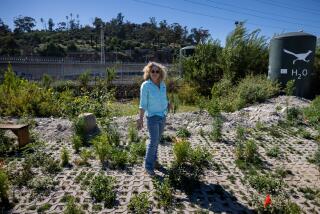PROFILE : Back to Nature : Photographer Brian Stethem revisited his childhood to produce a series on Sespe Creek.
- Share via
For centuries, rivers have seized the hearts and minds of poets and artists--not to mention the rest of us. As byways that nurture cities and replenish water supplies and make natural connections from mountain to sea, they’re worth their weight in metaphorical gold.
Creeks played a role in photographer Brian Stethem’s childhood in Fillmore. In the workshop on Old Telegraph Road he shares with his father, Jack, a painting contractor, Stethem talked about the old days, when more often than not the creek had water and a part of the river was stocked with trout.
“For a lot of us kids, it was really a playground. We used to go down there and catch lizards--there was all this wonderful stuff to play with. We called it ‘the riverbed.’ “People from back East would say, ‘This isn’t a river.’ ”
Creeks weren’t just about fun and games. As a youngster, Stethem acquired his taste for photography when he took his father’s Brownie box camera down to Hopper Creek, toward Piru. Much later, after studies at the Brooks Institute in Santa Barbara and Cal Lutheran, he would take his camera around the world, going to Costa Rica with the Peace Corps and taking two photographic expeditions to China.
But here and now, Fillmore has Sespe on the brain; the Sespe Wilderness, which backs up to the town, exerts a profound influence.
Fittingly, Stethem will be displaying his Sespe Creek work at the newly christened Sespe Gallery in the Chamber of Commerce, on Central just down from Sespe Avenue.
In the series, shot over the course of a year and a half, Stethem’s view of Sespe Creek is not, strictly speaking, a romantic one. Contrasts abound. Some images depict the dry, spindly brush lining the creek, but also the garbage and graffiti, unwanted human contributions on a bridge overhead.
In one image, we see a rare precious pool of water. Another finds a completely arid scene, with cracking mud that looks more like a turtle’s shell than a creek bed. “It looked like the moon to me,” he said.
“My interest, as far as photography goes, is the part of the creek close to Fillmore,” he explained, while standing over wet prints in the workshop. “I decided to use as my parameters the spot where it comes out of the mountains to where it spills into the Santa Clara River. This is not the wild Sespe. This is more affected by us, where it meets civilization.”
Although Fillmore is one of the last genuine small towns in the area, it has seen growth and suburbanization swallow up its agricultural landscape--orange groves have given way to housing tracts. In a sense, Stethem’s creek series touches on the theme of encroaching suburbia.
On a recent summer morning, he was anxious to show a reporter the subject firsthand, so we hopped into his pickup truck. Heading away from town and hanging a right on Grand Avenue, we note the acres of orange groves. At the end of the road, the creek meets the mountains and has a small amount of water. Out there, you can hear the faint rushing of water in the creek, and the chirping of crickets.
“One thing that interests me is the redemptive nature of the Earth,” Stethem observed at the “riverbed.” “It still seems to thrive in spite of what happens to it, like this creek. Because I keep returning to certain areas to re-photograph them, maybe after a week or two I’ll go down and people have had a party. They’ve had a fire and beer cans are everywhere. It’s sad. But, after the next spring when the water rushes through, it cleans everything out again and wipes that out.”
He shrugged. “I’m drawn to things that most people would find mundane.”
As a photographer, Stethem is generally interested in the road less taken. After graduating from high school in 1977, Stethem took classes at Humboldt State.
“That really opened my eyes. I got past the kind of stuff you see in the photo magazines--the pretty sunsets, how to use this or that filter to make it more red, and all that. It was pretty wild. That was a crash course in experimentation and new ways of seeing things.”
After getting a technical foundation at Brooks, he pursued more creative projects with Jim Hugunan at Cal Lutheran. “I’ve been influenced by a lot of those kinds of people. My biggest thing is collecting photo books. There are so many people I like. I try to look at everybody and absorb ideas without copying.”
Stethem does some commercial photography to make ends meet, as well as such supplemental work as carpentry, but would like to teach college while doing his own work.
Back in the upstairs apartment of the Stethem workshop, Brian is pulling out an older series of photographs that are the artistic opposite of his documentary creekside images. Entitled “Of Myth and Dream” and seen recently at the Santa Paula Theater Center and before that Thousand Oaks, the strikingly surreal, mock-historical series involves what he calls “myths, archetypes and heroes in our culture--and having some fun with it, too.”
There is his wife, Teri, posing in a south-of-the-border-like bordello and, in another shot, as the pistil in a fabric flower over which a mock bee is anxiously hovering.
“I shot all of these downstairs, and made the sets. That’s my dad there,” he said, pointing to a cowboy scene in which his father has donned chaps, a holster and a tough-guy mug.
Stethem is taking these concepts into a new series with, for the first time, nude subjects. “It’s along the same line, but not as literal. They don’t have as many props and they’re more impressionistic.”
Is he through shooting Sespe Creek?
“At least for the moment. I’ve done one installment. Now I’ll get people’s reactions.”
* WHERE AND WHEN
Photographer Brian Stethem will show his series “Sespe Creek” at the Sespe Gallery in the Fillmore Chamber of Commerce, 344 Central Ave., through Sept. 30.
UP CLOSE BRIAN STETHEM
On his relationship with Sespe Creek: “I have a real emotional connection with the creek. Who knows what’s going to happen in 10 or 20 years? These photos may be dated in terms of what happens next.”
On photographic series: “It works well for exhibits. I have to complete a certain amount of photographs in a given time. If I didn’t have that, it would be harder for me to keep producing work on a continual basis.”
On photographic traditions: “I try not to follow composition rules in my landscapes, but I feel that I’ve learned them so that I have a right to. Some people say they want to break them, but they don’t know what they are.”
More to Read
Sign up for Essential California
The most important California stories and recommendations in your inbox every morning.
You may occasionally receive promotional content from the Los Angeles Times.













